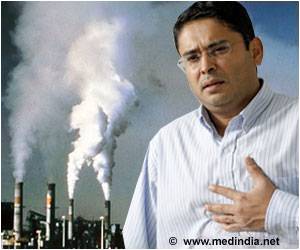
The results also show that the particles that envelop pollutants also benefit from this arrangement. "What we've learned through fundamental studies on model systems in the lab has very important implications for long-range transport of pollutants in the real world," said physical chemist Alla Zelenyuk of the Department of Energy's Pacific Northwest National Laboratory. "In this study, we propose a new explanation for how PAHs get transported so far, by demonstrating that airborne particles become a protective vessel for PAH transport."
Floating in the air and invisible to the eye, airborne particles known as secondary organic aerosols live and die. Born from carbon-based molecules given off by trees, vegetation, and fossil fuel burning, these airborne SOA particles travel the currents and contribute to cloud formation. Along for the ride are pollutants, the PAHs, that have long been thought to coat the particles on their surface.
For decades, atmospheric scientists have been trying to explain how atmospheric particles manage to transport harmful pollutants to pristine environments thousands of miles away from their starting point. The particles collected in areas such as the Arctic also pack higher concentrations of pollutants than scientists' computer models predict.
The predictions are based on the assumption that the particles are like liquid spheres, whose fluidity allows PAHs to escape. But they don't escape, and one recent advance has helped to pin down why PAHs are remaining stuck in their particle lairs. Zelenyuk and her colleagues at EMSL, DOE's Environmental Molecular Sciences Laboratory at PNNL, developed an ultra-sensitive instrument that can determine the size, composition and shape of individual particles.
Called SPLAT II, the instrument can analyze millions of tiny particles one by one. The ability of this novel instrument to characterize individual particles provides unique insight into their property and evolution.
Advertisement
Armed with this data, Zelenyuk and researchers from Imre Consulting in Richland and the University of Washington in Seattle set out to determine the relation between the SOA particle and the PAHs. Again they used alpha-pinene for the SOA. For the PAH, they used pyrene, a toxic pollutant produced by burning fossil fuels or vegetation such as forests.
Advertisement
With the pyrene-coated particles, the team found the PAH pyrene evaporating off the surface of the particle quickly, all of it gone after four hours. By the next day, the particle itself had shrunk by about 70 percent, showing that the alpha-pinene SOA also evaporates, although more slowly than pyrene.
When they created the particles in the presence of both SOA and PAH, the PAH evaporated much more slowly. Fifty percent of the original PAH still remained in the particle after 24 hours. In addition, the SOA particle itself stayed bulky, losing less than 20 percent of its volume.
These results showed the team that PAHs become trapped within the highly viscous SOA particles, where they remain protected from the environment. The symbiotic relationship between the atmospheric particles and pollutants surprised Zelenyuk: SOAs help PAHs travel the world, and the PAHs help SOAs survive longer.
Zelenyuk and her colleagues performed comparable experiments with other PAHs and SOAs and found similar results.
In the real world, Zelenyuk said, the evaporation will be even slower. These results will help modelers better simulate atmospheric SOA particles and transport of pollutants over long distances.
This work was supported by the Department of Energy Office of Science and PNNL's Chemical Imaging Initiative.
Source-Eurekalert









